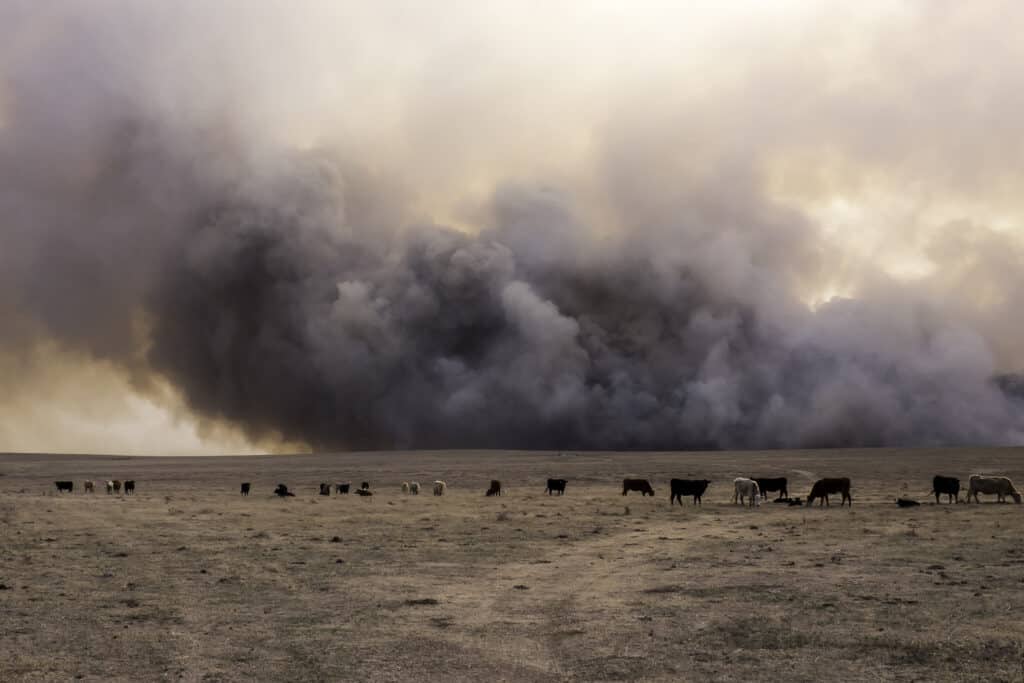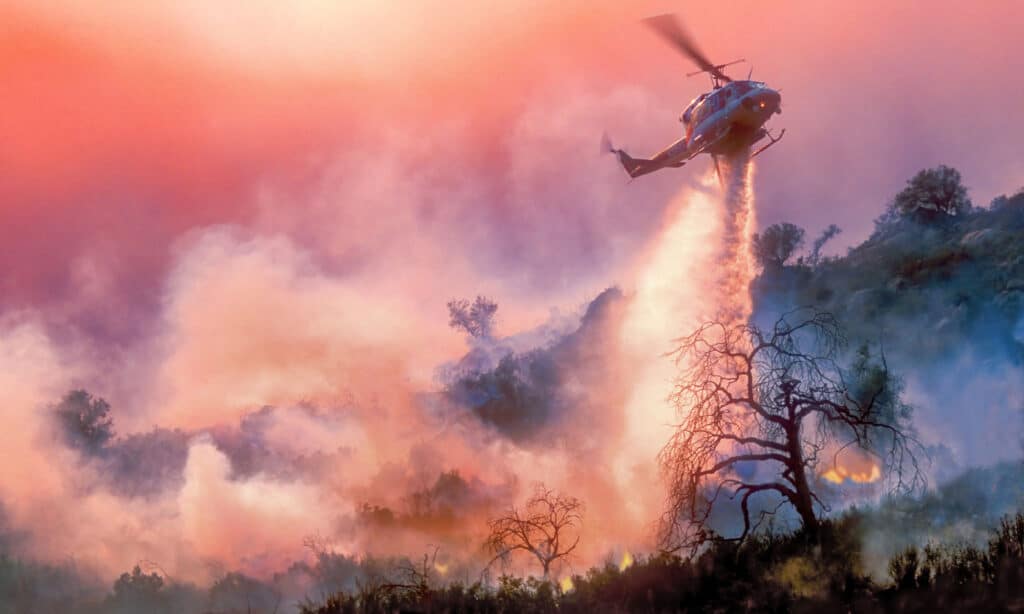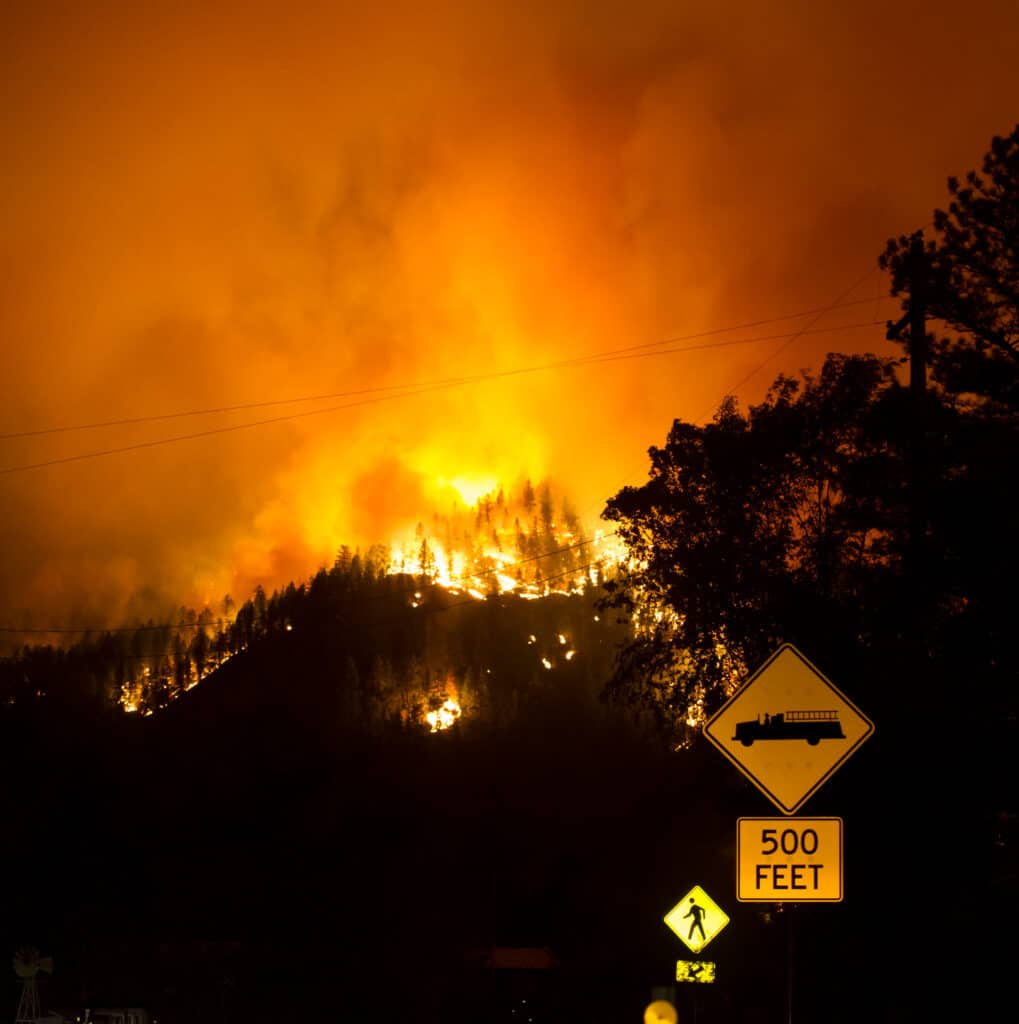The natural beauty of lush forests, towering mountains, and rolling hills graces the wild expanse of Washington State. This incredible place is highly susceptible to wildfires. A natural phenomenon intricately woven into the fabric of nature. However, it can be sparked, literally and most unfortunately, by human action. This article delves into the intricacies of wildfire season in Washington State, illuminating its general season, peak season, risk factors, highest risk areas, its effects, management, and more.

In Washington State, the wildfire season ranges from summer to autumn, peaking from mid-July through mid-September.
©Christian Roberts-Olsen/Shutterstock.com
Wildfire Season in Washington State
Wildfire season in Washington is not a static occurrence but rather a dynamic interplay of environmental factors that often occur within a similar timeframe each year. This dry and tumultuous season typically transpires from summer through late autumn and peaks from mid-July to mid-September. This extended duration is due to the state’s unique climate variations. The western half of the state, west of the North Cascade Mountains, has a predominantly oceanic climate. In contrast, the eastern half of Washington, east of the North Cascade Mountains, has a semi-arid climate. That said, central Washington is at the highest risk for wildfires.
Within this expansive period, there is a critical juncture when the risk of wildfires reaches its zenith. The peak fire danger months span from mid-July to mid-September. During this time, many factors combine to elevate the risk of wildfire outbreaks. High temperatures, dry conditions, little precipitation, and reduced humidity create conditions conducive to the rapid ignition and spread of fires. Additionally, the parched vegetation from the preceding dry months becomes highly flammable, amplifying the threat.
Wildfire Management
As stewards of this delicate ecological balance, Washington State has harnessed its knowledge and resources to enact comprehensive strategies to manage the wildfire season. At the heart of these efforts lies the Washington State Department of Natural Resources (DNR), a proactive agency tasked with safeguarding the state’s natural resources, including its expansive forested areas.
The state’s approach encompasses both prevention and suppression. Rigorous prevention efforts are grounded in public education. Residents are educated about the importance of fire-resistant landscaping, responsible fire usage, adherence to burn permits, and adherence to burn bans. The DNR also collaborates with local communities, employing Firewise programs to fortify homes against potential wildfires.
As for combating active wildfires, many entities play pivotal roles in management. From local to regional entities, they all maintain organizational and leadership efforts, which include specialized firefighting equipment and nurturing a network of well-trained firefighters primed to combat wildfires with precision and efficiency. Furthermore, this strategic synergy extends to partnerships with federal entities, including the U.S. Forest Service and the Bureau of Land Management.
The Washington State National Guard emerges as an ally during times of escalated wildfire activity. With a fleet of helicopters modified for helicopter bucket operations and skilled pilots adept at precision drops, the National Guard contributes a vital aerial dimension to wildfire suppression.

Wildfires can impact humans, animals, businesses, and the economy.
©Eugene R Thieszen/Shutterstock.com
Highest Risk Areas
Though wildfires are a natural occurrence in nature, a significant proportion of wildfires arise from human activities. Activities such as discarding cigarette butts, neglecting campfires, or setting off fireworks near dry vegetation can provide the spark that sets a massive wildfire in motion. Electrical malfunctions, power lines interacting with vegetation, and sparks ignited by machinery can further compound the risk.
Yet, nature also plays a role in kindling these fires. Lightning can ignite forests with its potent touch. A single lightning strike, capable of igniting dry vegetation, can set the scene for a wildfire to take root.
Climate and Terrian
Within Washington State’s diverse expanse, certain regions emerge as vulnerable landscapes susceptible to wildfires. The North Cascade Mountains, with their massive forests and plantlife across mountainous terrain, and central and eastern Washington, characterized by its semi-arid climate and vast shrubland and grassland expanses, are both particularly prone to wildfires. The volatile combination of dry vegetation, prevailing winds, and arid conditions form the perfect conditions for wildfires to begin and expand in a very short amount of time. The sprawling forestland, rugged mountains, and expansive valleys witness recurrent wildfires due to the intricate interplay of climate and vegetation.
At-Risk Towns and Regions
Overall, central Washington experiences the most wildfires in the state. From the verdant North Cascade Mountains to charming towns and landscapes like Leavenworth, Okanogan, and Chelan, the threat of wildfires is most prevalent. Although diverse in their topography and character, these at-risk places share a common thread of susceptibility to wildfires.
The majestic North Cascade Mountains, a rugged realm where alpine grandeur meets untamed wilderness, epitomize the delicate balance between nature’s most magnificent and perilous. Leavenworth, a picturesque Braverman-themed town nestled against a backdrop of towering mountains, exemplifies the vulnerability of communities of rural regions. With its semi-arid climate and vast grasslands, the sprawling Okanogan region is no stranger to the occurrence of wildfires. Moreover, nestled along the shores of Lake Chelan, the town of Chelan exemplifies the intricacies of wildfire risk management in a tourism-centric community. Communities like Entiat, Ellensburg, and Cle Elum, residing within the embrace of picturesque landscapes, are other highly vulnerable locations.
The at-risk places of Washington State, from the charming towns to the rugged mountainsides, exemplify the ever-present threat of wildfires. The state’s inhabitants, united by a shared commitment to safeguarding their homes and heritage, engage in a perpetual struggle to harmonize human activities with the dynamic forces of their environment. Moreover, through vigilant preparedness, collaboration, and unwavering dedication, these communities work to coexist within these at-risk lands.
Factors of Wildfires
The orchestration of wildfires is due to factors that converge to elevate the risk. Foremost of these factors are prolonged periods of drought and reduced precipitation, which lead to dry vegetation. The warm, dry winds of the region further exacerbate the hazard, rapidly spreading fires once ignited.
Furthermore, the topography of the land contributes to the spread of wildfires as well. Steep terrain, characteristic of many Washington landscapes, poses challenges for firefighting efforts, impeding the rapid movement of personnel and equipment and allowing fire to move quickly.
How Communities Manage and Mitigate Wildfires
Human influence in shaping landscapes and the natural environment also casts its shadow. Though wildfires are a natural occurrence in rural areas, humans have settled on these lands. These interfaces, where human settlements reside in wild areas, present a complex challenge. Here, the potential for wildfires to encroach upon communities escalates, necessitating intricate strategies to safeguard lives and property.
Washington State assumes a proactive stance in managing and mitigating wildfires. Vigilance begins with public awareness campaigns, advocating for responsible outdoor activities and adherence to burn bans during peak fire danger months. Furthermore, partnerships between government agencies, local communities, and environmental organizations forge a united front, fostering community and preparedness.
Fire management tactics encompass a blend of prevention and response. Prescribed burns, controlled fires executed under specific conditions, serve as a strategic tool to reduce accumulated vegetation and minimize the potential for catastrophic wildfires. Additionally, Washington State is home to a robust population of firefighting fleets and highly trained firefighters to battle wildfires on multiple fronts, valiantly safeguarding the people who live here.

National, state, and local officials work together to prevent, mitigate, and manage wildfires in Washington State. Some entities include the Washington State Department of Natural Resources, the U.S. Forest Service, the Bureau of Land Management, the Washington State National Guard, and numerous other local officials.
©iStock.com/David Aughenbaugh
Dangers of Wildfires
Wildfires touch all facets of life, from humans to animals, buildings to businesses, and even tourism and the economy, often resulting in devastation and disruption.
Effects on Humans and Animals
Evacuations are a harsh reality of wildfires, forcing families to leave behind their homes and sometimes animals without a guarantee that anything will remain when it is safe to return. The ominous glow of fires on the horizon and the encroaching smoke cast a shadow of uncertainty, testing the resilience of communities. The loss of life, homes, cherished possessions, and no sense of security can leave scars that transcend physical damage. Hikers and backpackers can find themselves in the path of danger if a wildfire starts or moves into their location while they are far from the trailhead.
Beyond the immediate impacts, the toll on human and animal health is significant. The intense smoke that billows from wildfires carries a toxic brew of particles, chemicals, and pollutants that pose significant health risks. Respiratory ailments, exacerbated by the polluted air, afflict those in proximity to smoke, which can carry for thousands of miles depending on the wind. Moreover, vulnerable populations, including the elderly, children, and those with preexisting health conditions, bear the brunt of these health hazards.
Effects on Buildings
Residential and commercial structures caught in the path of a wildfire are reduced to smoldering ruins. The emotional toll on property owners is immense. Local economies suffer as businesses and resources are burnt to the ground, robbing communities of both livelihood and stability.
Effects on the Economy and Tourism
The economic repercussions of wildfires are far-reaching, leaving indelible marks on communities and industries. Tourism, a pillar of Washington State’s economy, suffers a blow as smoky skies and closed roads close off many popular tourist attractions. In addition, natural resources or large commercial warehouses in wildfire locations can get caught up in the repercussions of wildfire activity of damage. This can result in a ripple effect felt near and far due to an inability to fulfill supply demands.
Mortality
The gravest toll that wildfires exact is the loss of human life. The tempestuous nature of wildfires, their capricious shifts, and unpredictable trajectories can trap even the most prepared individuals. While figures for fatalities are often few from year to year, the threat is always palpable. There is always the possibility of loss.

Though devastating, wildfires are a natural occurrence in nature and serve an important purpose in renewing the earth, improving the nutrient content of the soil, and creating new habitats for animals and plants.
©Newtonian/Shutterstock.com
Parks Burn Ban Levels in Washington
State Park officials in Washington set burn bans to protect people and shield the land they manage from potential devastation. These burn bans are a good indication of burn bans or restrictions found across the state as well. Furthermore, it consists of a carefully calibrated hierarchy of burn ban levels, each a response to the ebb and flow of fire danger.
Level 1 Burn Ban: Low Fire Risk
During this phase, the call to vigilance reverberates across communities and landscapes. Residents must begin to exercise heightened caution, curbing outdoor activities that could inadvertently ignite a fire. Fires are only allowed in designated fire pits. Moreover, this early precautionary measure serves as a reminder of the delicate balance between human activity and the fire-prone ecosystem.
Level 2 Burn Ban: Medium Fire Risk
During this phase, the reins tighten further, regulating activities with a meticulous eye. The objective is to minimize the potential for fire amongst the vulnerable landscape. Wood fires are restricted to fire pits and only within designated areas. Charcoal may be restricted, while gas and propane are allowed. Furthermore, the level two burn ban encapsulates the state’s proactive stance, seeking to avert risky fire activity.
Level 3 Burn Ban: High Fire Risk
When the forces of nature conspire to elevate fire danger, the level three burn ban comes into effect. This critical juncture heralds a stringent curtailment of activities that could potentially ignite wildfires. No charcoal or wood fires are allowed. However, gas or propane self-contained camping stoves and gas or propane fire pits are allowed. During this phase, the true gravity of the situation is unveiled, a stark reminder of the unforgiving nature of the elements and the necessity for unwavering caution.
Level 4 Burn Ban: Extreme Fire Risk
The level four burn ban leaves no room for error, as the risk of wildfires reaching catastrophic proportions is probable. Open flames of any type are strictly prohibited. Smoking is not allowed, either. To ensure the safety of those traveling into the wilderness, trails and undeveloped areas may be closed to entry. Stoves in Internal RVs are allowed. Furthermore, the transition to a level four burn ban carries the heavy weight of the responsibility of everyone living or traveling through the restricted areas.
No Fires
Finally, officials can restrict certain areas with the No Fires Burn Ban. This burn ban states that no fires are permitted at any point or any time of year.

Wildfires are an annual occurrence in Washington State. The most at-risk region is central Washington, including the North Cascade Mountains, Okanogan County, and cities such as Leavenworth and Twisp, just to name a few locations.
©Dawn Wilson Photo/Shutterstock.com
Conclusion
Wildfires in Washington leave an unforgettable mark on the state’s ecosystems, communities, and natural landscapes. From the verdant expanse of the North Cascade Mountains to the many towns scattered throughout the high-risk areas, the threat of wildfires looms as a reminder of the fragility of coexistence.
Moreover, wildfire season ranges from summer to autumn, peaking from mid-July through mid-September. As the fire danger rises, state and local officials set burn bans and restrictions to protect people, buildings, and nature. And the air becomes imbued with caution. Human activities and natural phenomena alike can ignite the flames that transform all in its path. The delicate interplay of climatic conditions, terrain, and vegetation dictates the ebb and flow of fire risk. From preparedness to preservation, the state’s inhabitants unite to defend their homes, livelihoods, and cherished environments.
Furthermore, wildfires demand vigilance, adaptation, and respect for the forces that shape the land. The struggle against wildfires paints a vivid portrait of the human-nature nexus. Caution and collaboration intertwine in the efforts of prevention, protection, and perseverance in navigating wildfire season in Washington State.
The photo featured at the top of this post is © Christian Roberts-Olsen/Shutterstock.com
Thank you for reading! Have some feedback for us? Contact the AZ Animals editorial team.







